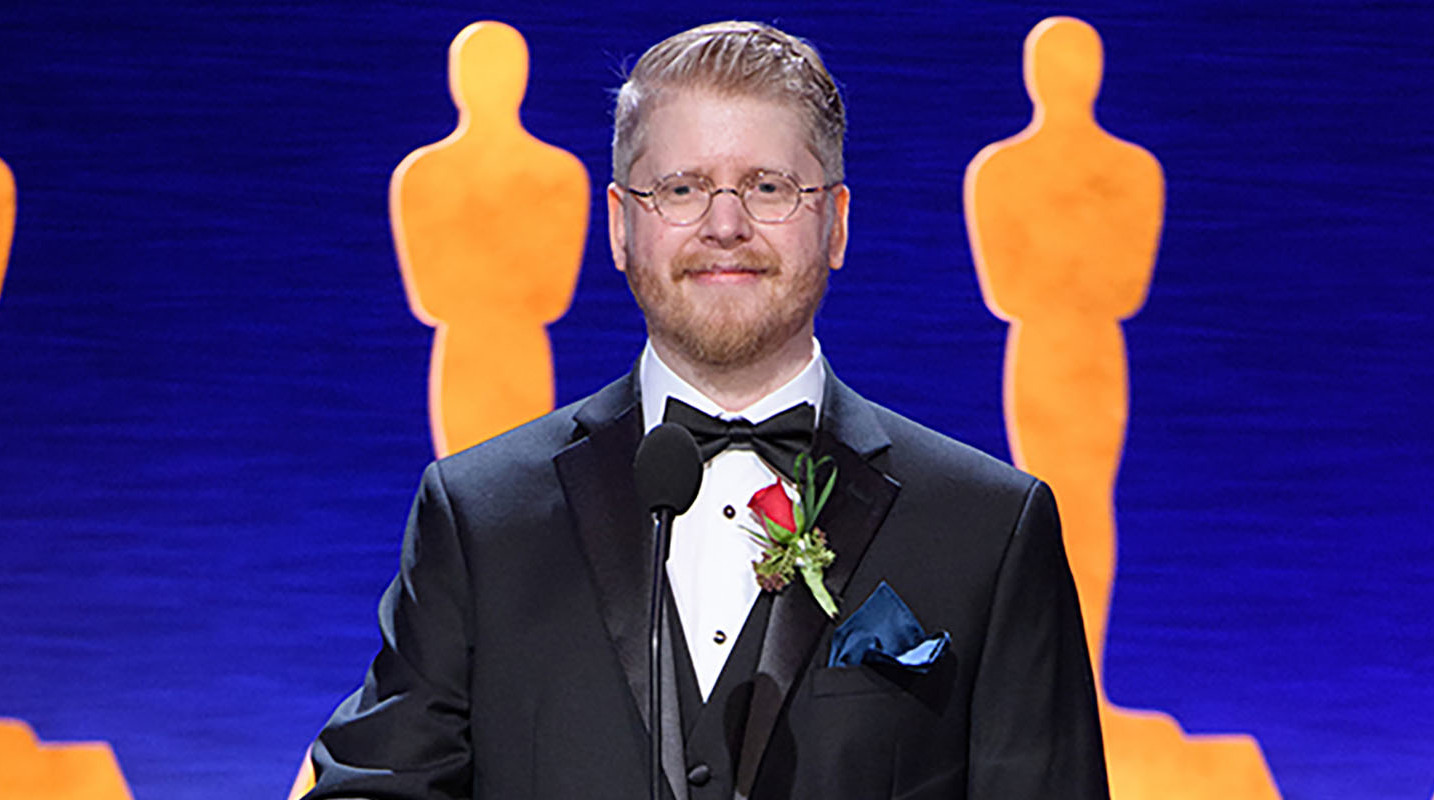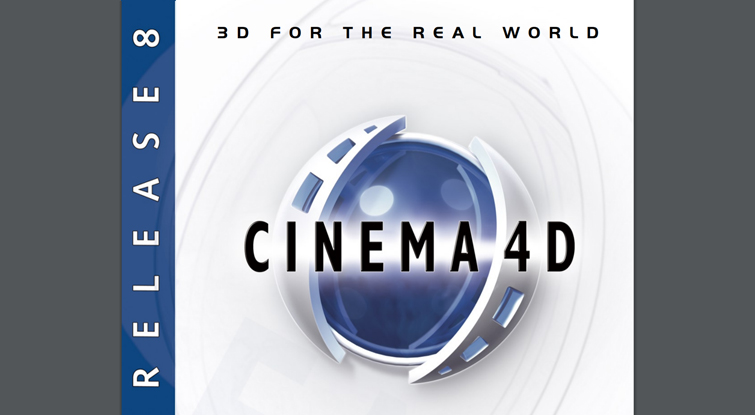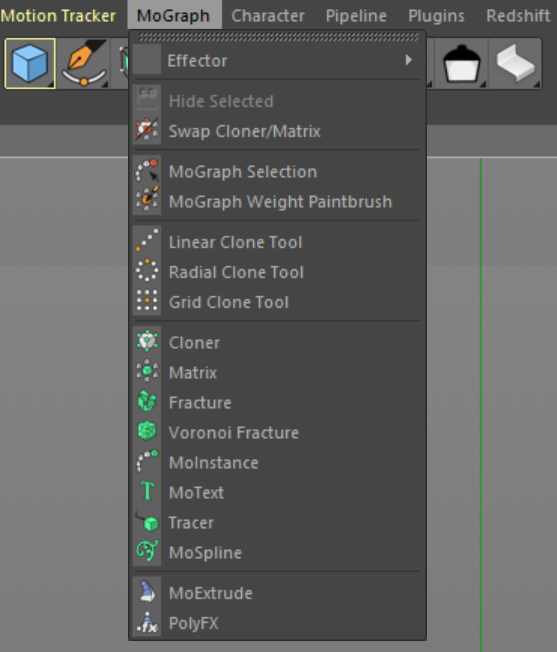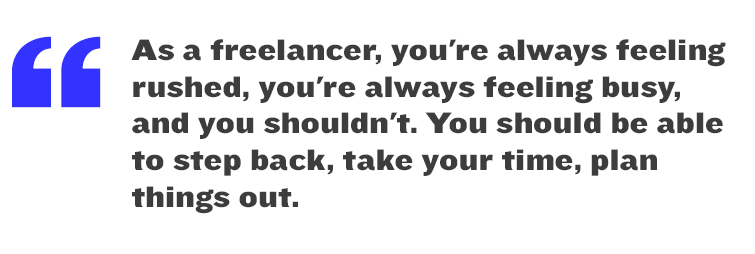
Cinema 4D’s Lead Developer talks about the now Academy Award-winning MoGraph toolset in C4D, which earned a Scientific and Technical Award.
Though the films themselves often take the spotlight during the Oscars, this celebration of achievement in production extends far beyond the last year’s movie releases. In addition to the Oscars, the Academy of Motion Picture Arts and Sciences (A.M.P.A.S.) celebrates outstanding achievements with Scientific and Technical Awards.
We previously talked about Cinema 4D’s MoGraph tools earning a Scientific and Technical Award from the Academy of Motion Picture Arts and Sciences, and since we have had the opportunity to talk with Maxon’s Cinema 4D Lead Developer Per-Anders Edwards about their achievement.
Here’s our conversation.
Per-Anders Edwards Interview

Per-Anders Edwards at the award ceremony. Image via Todd Wawrychuk / ©A.M.P.A.S.
Michael Maher: Mr. Edwards. Thank you so much for joining us today. I’d like to start off with the basics. Can you first tell us about yourself?
Per-Anders Edwards: My name is Per-Anders Edwards. I am the current lead developer and one of the designers of MoGraph for Cinema 4D.
I grew up in England, and I started my career basically working in events and corporate production for quite a few years. Eventually, I met my wife and decided to move to California.
After the move is when I really switched over to 3D. I’d been using computer graphics CG software before, however not as a full-time gig. So when I came here I decided to focus a bit more. Unfortunately, I moved just when Dot flop happened.
Michael: Perfect timing.
Per-Anders: Worst possible timing. I had a promise of a job with one of the design agencies, and of course they collapsed. So, I’m just like, ‘Oh crap, okay, better pick something up pretty fast.’
I’m not sure why I picked computer graphics at this point, but I just did. It was one of those things. Maybe I’d been inspired by all the movies, seen some Pixar stuff and all the rest of it around there. I thought web stuff was no longer something I can invest time in, because it’s not gonna get a return quickly. So, quick jump to something else.
At the time, there were lots of people who needed visualizations, tech visualizations or medical and corporate stuff. I started doing that with computer graphics. I’d already been using various applications, and for some reason I picked up on a series of websites where people started to talk about Cinema 4D.

I think it was [release] eight which was out, which to me was very familiar. I was looking at it and was going, well that timeline reminds me an awful lot of timelines I’ve used elsewhere. I was using it and I was thinking, you know what? I always assumed that the applications that I was already using were fast. But I found out that I was much faster in Cinema 4D. Its workflow just clicked with me.
I started to meet various people like David Farmer, who was part of a plugin development company who produced a famous series of shaders called Smells Like Almonds. Those shaders are now in Cinema 4D, they form the basis of much of our noise system.
I was learning [Cinema 4D] through the forums, sharing my experience and answering other people’s questions as a means to teach myself. That actually opened up the door for me. These people were producing plugins, and there are still some things which I’d like for Cinema 4D to do. So I started to learn to program.
Michael: That is fascinating. I also come from a production background which guided me here. I was in live production for quite some time, and spent many years as a video editor. My Cinema 4D skills were very limited very early on. I would be working on an edit and I might need some 3D titles or some graphics or something like that. Now that I’ve spent so much more time with the community recently, it just seems like so much of it stems out from this traditional corporate events world.
Per-Anders: Speaking of that sort of thing, I had that similar sort of situation except the production house I was in, we actually had a dedicated 3D department to do titling. But a lot of the time I was so naïve, I would just actually do that in Photoshop. I’d try and quickly make it because back then, it took some time to render, even these things.

Michael: I still recall my early edits before I even tried to do After Effects or anything I would just layer and layer and layer on top of my video timeline and then start animating through Final Cut. A very complicated process to get a little movement until I realized how much easier it could be when I actually sat down and learned the tools properly.
Per-Anders: Yeah, I think that’s a natural path in revelation for many people. You start out and master a single tool, and once you’ve mastered that you become very comfortable staying in that tool and not realizing that perhaps there are superior alternatives.
You have this one day where you’re like, okay, I’m going to give this other tool a try. That or it might be a single project where a client specifies you’ve got to use this tool because that is their in-house tool and everything’s got to work with it. You take on a job, and you pick up a tool, and after a short time you realize it’s actually much faster.
The fear of having to make a new pipeline that includes another tool is far bigger than actually doing it. Just making that first step is all it takes.
Michael: That’s a good segue. What was missing from your workflow that led to the development of MoGraph?
Per-Anders: MoGraph tools came about from my experiences in events, then later working on freelance jobs. As a freelancer, you’re always feeling rushed. You’re always feeling busy, and you shouldn’t. You should be able to step back, take your time, plan things out. Stepping back is probably the single most important thing I could suggest to any freelancer coming in. Stand back first, for five minutes, then make your first move.
I found I was doing a lot of stuff that required some technical level of proficiency in the application, but I didn’t ever have the time to do it on the job. When you’re on the job, you have scheduled so much time for modeling, this much time for texturing, this much time for rendering. I know that to get this rendering done, even with the render farm, it’s going to take X amount of hours.
It’s the same reason you don’t want learn another application, you realize you can do it easier [with the tools you know] but you’re making too much haste. You’re not really taking the time that you need, you’re not stepping back.
Terry Prach had this wonderful old maxim which was, ‘There’s the easy way and the hard way, and the difference is the hard way works.’
That’s basically it. That’s the approach. You’re always trying to do things the easy way, and you eventually find out that it’s more painful. It takes longer and gives you bigger a headache and you don’t get as nice a result.

Michael: Once artists started using MoGraph to step back and save some time, did you immediately see the tools being used in ways you hadn’t anticipated?
Per-Anders: I think that it’s been an ongoing process. People are still impressing me today with new stuff that they’re doing with this tool set which is now 13 years old, I think. And they’re doing amazing things that I’m like wow, really? How? That’s the ingenuity, that’s the beauty I think of motion graphic artists in particular. They’re kind of the grease monkeys of the CG world, they get their hands in there, get dirty and come out with these beautiful things and it’s really incredibly impressive.
I think people discover stuff, they go through an initial phase where they use presets essentially. Then from there they start to experiment further. You start to get more comfortable. Again, it comes back to that being comfortable with the tool. You become more and more comfortable to the point where oh I can do anything with the tool and that’s great, but that also means we’re now reaching perhaps the limits of where MoGraph is at this point.
Michael: How did that help MoGraph evolve to add new features?
Per-Anders: I think that one of the great things that Paul [Everett] and I did at the beginning was to make sure that Cinema 4D and MoGraph were very tightly interconnected. Pretty much anything added to the objects system and a lot of things that added to the shader system, they immediately become extensions of MoGraph. And I like that Cinema 4D, the idea that many things are tied together. You don’t have so many islands of features. You have a more coherent tool set.
I really feel like the strongest things, the things that I really felt were standout, were probably features like when the bullet dynamics were first introduced, which were done by Erwin. And that was something which I wanted for a long time and when we brought that out, that obviously opened a lot of gates. Because people wanted to do that already, but they were struggling with the previous dynamics system which wasn’t really geared up for dealing with motion graphics.
Another great release was the fracturing. Again, it was one of these features which was a long time coming, but it was so nice to see it in there and so powerful. I think the trouble is that I can go through every single release and say that made it so much better. Every single thing we create, adds to the motion graphics artist’s tool set.
MoGraph just happens to be a section of this, perhaps it’s not even a section, it’s maybe a heart around which many things might hang for a motion graphics artist. But at the same time, this is the whole package. The whole package to me is more and more powerful as a motion graphics tool set over the years.
Cinema 4D didn’t used to be motion graphics focused, none of the 3D apps did. With MoGraph we’re suddenly talking about motion graphics workflows, workflows for freelancers who want to direct large numbers of objects and not have to surrender the power over to a dynamics system.
MoGraph side steps that and gives artists direct control and that workflow perhaps, all of the workflows we added, they’re focused on some tasks, but largely on tools which are general purpose and designed to be honest, largely around my own laziness.
Michael: The best tools come out of laziness.
Per-Anders: Absolutely. Laziness achieves far more than actual effort. People are willing to put much more effort into being lazy than they are into actual work. Fortunately, everyone else also wants to be lazy so MoGraph was a huge success.
Michael: Mark it as a win. Where are you currently seeing Cinema 4D and MoGraph used in ways that surprised you?
Per-Anders: Obviously the most visible thing that everyone thinks of first if they were to answer that question would be movies. Future user interfaces and all that kind of stuff you see. The interfaces from Iron Man or Black Panther, and that stuff of course is also motion graphics.
The Avengers Find Their Way With C4D and City Kit via Jayse Hansen / Marvel.
Traditionally in film, that would be handled by the VFX companies but now increasingly with the demise of some of these large houses, we’re seeing smaller houses providing film quality VFX with a small team of artists.
Of course with motion graphics, it’s even more key that you have a single artist working on a whole shot. So the ability we’re given by making the tools and the workflow fast means a single artist can do a whole film quality shot themselves from start to finish. Maybe they won’t do the color grading but they will do everything up to that point. That’s much harder to translate into a larger team when you’ve got a pipeline with one person doing one specific thing. A good art director can do it but it’s more expensive, it takes more time, there’s a lot more communication involved.
Michael: Do you see any other avenues for motion graphics in the future?
Per-Anders: Obviously real-time will likely be a big part. Motion graphics, it’s very nebulous. It’s very hard to pin down exactly what motion graphics is and what the future is of it because of that. Because you have so many fantastic artists, each with their own ideas and they’re each doing what is motion graphics. It’s visual, it’s animated graphics on the screen. How do you predict that? You can’t really but you can focus on delivering certain tools.

Michael: How do you decide on delivering new tools?
Per-Anders: I still work as a motion graphics artist as well, I’m not just a developer. I’m sitting there going, you know, this really stinks. I want to do it this way. I don’t want to have to deal with all that. Next time, note to self, fix this. And that’s where a lot of the stuff comes from, like I said, laziness and a desire to fulfill clients and have an easier life and reach the Bahamas sooner.
Michael: So it’s more of a constant push of its limits, then evolution.
Per-Anders: I think that philosophy, that’s something that is at the heart of Cinema as well. That’s what makes it so good, it’s an abusable system to begin with and that makes it a good foundation for MoGraph. Perhaps that’s one of the reasons why when I first picked it up it clicked more with me because it was like, oh of course I can do that but I’ve also got this procedural workflow as well as a non-procedural workflow for modeling. I’ve got these tools which are pretty friendly but I can abuse them, I can use shaders in areas that shaders traditionally aren’t used.
This is something which, whether wittingly or unwittingly, been designed as a perfect playground for a freelancer.

Image via Todd Wawrychuk / ©A.M.P.A.S.
Michael: Well let’s switch gears, why don’t you tell us a little bit about the award you’ll be receiving from the Academy of Motion Picture Arts and Sciences.
Per-Anders: Yeah, well the scientific technical certificate, it’s amazing. It’s really astonishing. The process is something which … it’s not clear to the outside world.
This year we happened to be nominated and we went in, had these interviews with these stern industry professionals. They’re all fantastic people, these are some really impressive names in the industry. You’ve got the people who designed Houdini, various heads of R&D at big name companies. And they’re involved in the process.
This is not one person’s decision, this is a whole group of people and they sit down and they decide. You go through this process and of course the first thing you think after you’ve done this is, oh god that went terribly. I’ve got no chance. I’ve ruined it.
Six months later or something, you hear this, “The Academy is pleased to announce blah, blah, blah.” and my name’s up there and I’m like … Really? Wow.
You get blown away, it’s difficult to process. You grow up with the Oscars and the Academy Awards, it’s a piece of pop culture. It’s something which is talked about everywhere, all over the world. And so to see your name up there with the Academy logo at the top and all the rest of it, that’s like, wow. This is a point where you feel recognition, like I’ve made it.

To get my name up there is wonderful, but it’s a process of many people over the years. It’s recognition for the work that other artists have done. And you know, it’s that stuff that keeps it alive because we wouldn’t be up there if the artists themselves hadn’t invested, hadn’t bought in to MoGraph and continued to use it.
It obviously matters how much we work at it and improve it, but without the users giving it life, then obviously no one’s going to pay attention. And it’s because of the users doing what they’re doing, doing all this amazing stuff that the Academy does pay attention.
The fact that you guys have stuck with us means so much, it means a return and it means we can develop more cool tools to improve this. We believe in motion graphics artists as well, it’s a two way thing. They believe in us, we believe in them and it’s wonderful to see.
This also represents the Academy now recognizing motion graphics as a legitimate art form. As a legitimate thing, not just us. Not just myself, not just Maxon and all the incredibly talented developers. This is like we’ve landed, motion graphics, we’re no longer some little corner of the design scene.
Michael: Well thank you so much, this was great. A wonderful learning experience for me and I appreciate your time. Congratulations to you and your team, and enjoy the Oscars.
Per-Anders: Well I appreciate having the opportunity. Thank you very much.
Award Acceptance Speech
Since our interview, Per-Anders Edwards has officially received the Scientific and Technical Award for MoGraph.
Courtesy of the A.M.P.A.S., you can watch the Cinema 4D MoGraph award presentation below.

